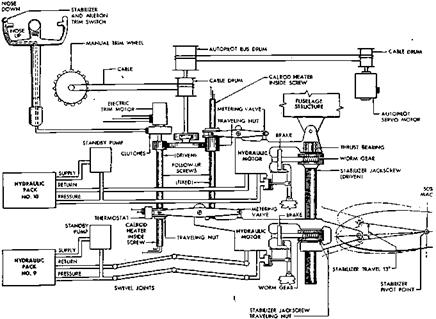The B-52 Manually Controlled Ailerons Are Small
The B-52 has only the smallest of ailerons, in the conventional sense. The ailerons are of conventional chord, but their span is only about equal to their chord. They are quite aptly called “feeler ailerons,” in that their main function is to supply control forces to the pilot’s yoke. Spring tabs are used on the feeler ailerons. Six upper surface spoiler segments on each wing provide the real roll control power for the airplane. The spoiler actuators get their signals to come open from the rotation of the pilot’s control wheel, requiring no pilot effort to operate.
The spoiler aileron system adopted for the B-52 was originally tested on a B-47, after that airplane exhibited a marked loss in conventional outboard flap-type aileron power due to wing twist. The spoiler system worked well on the B-47, but the Air Force declined to make the change on that airplane. The B-52 can be landed using the feeler ailerons alone, if all
|
Figure 7.6 Schematic ofthe Boeing B-52’s stabilizertrimcontrols. Two independenthydraulic motors drive the stabilizer, onethroughthejackscrew, the otherthroughthejackscrew’straveling nut. The valve of each hydraulic motor is controlled by electric trim motors, with mechanical backup. (From B-52 Flight Manual, 1956) |
spoilers are inoperative due to hydraulic power failures, for example. Successful landings are possible under benign wind and turbulence conditions.
In the late model B-52G the feeler ailerons have been eliminated and an extra spoiler segment has been added. The B-52G flight manual advises that limited lateral control is available by sideslipping the airplane with the rudder, if all spoilers are inoperative. Landings are “not advised” by the flight manual, meaning that the crew is expected to bail out if all spoilers become inoperative.
CHAPTER 8














